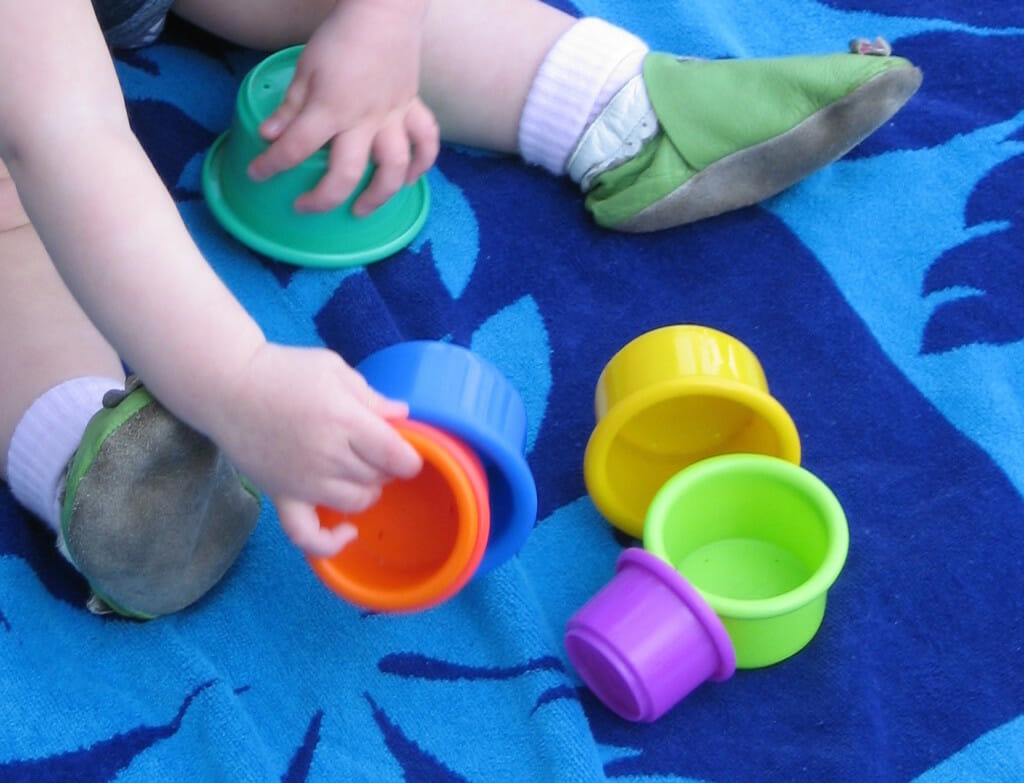My husband teaches math for a living. To kiddos much older than ours.
Because of this, I wasn’t surprised when my friends began asking me, years ago, what we were doing to teach the girls math.
Truth is, when the girls were still infants and toddlers, I was the one with them most of the time, so what they learned (or didn’t) was squarely on my shoulders.
And I have zero training in how to teach math to anyone, let alone to children age five (which Kimmie is now) and under. So anything I’ve done that’s worked, has been largely by trial and error.
Over the past year or two, my husband has begun actively supplementing my efforts more. Now that Kimmie is in kindergarten, it seems our attempts have succeeded more than not.
So if you’re wondering how we gave our children a head start in this area, in the hopes of doing the same for your offspring, read on – keeping in mind that these examples come not from a math expert, but from a mama who slept through half of her 8am calculus classes in college, and hasn’t taken a math class since.
1. Count. Everything.
All the parenting advice on helping your kids learn to speak, build vocabulary, and someday become fluid readers stresses how important it is for you to talk to your kids constantly. Narrate the day and the world around you, read them lots of stories, that sort of thing.
Well, numbers and math are their own sort of language, so there’s no reason not to start giving your kids lots of this language early on, too.
Yes, I felt totally ridiculous talking seemingly-to-myself when I took Kimmie out for those long walks in the stroller, narrating to her the passage of seasons and explaining how the leaves turn colors in the fall, fall off the trees by winter, bud again in the spring, and form a dense shady canopy by summer. But I did it anyway.
As we walked, I also counted out loud for her how many doggies we passed in our neighbors’ yards, how many houses or cars we saw of different colors, and how many apples or limes or what-have-you I put into our cart when we shopped at the grocery store.
And when we collected our weekly CSA share, where the farmer had bins of produce and signs specifying how many of each item our weekly share included, I counted the onions and zucchini out loud in front of Kimmie as I put them into our bag.
As soon as she could, she wanted to do the counting and selecting for me.
2. Count along in number books
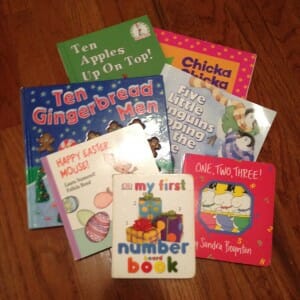 The early-education experts encourage parents not just to read books aloud to their kiddos, but to do so actively. Put some expression in your voice. Point out details in the pictures that relate to the words you’ve read. Point to the words on the page as you read. Ask your listeners questions, like what they think might happen next.
The early-education experts encourage parents not just to read books aloud to their kiddos, but to do so actively. Put some expression in your voice. Point out details in the pictures that relate to the words you’ve read. Point to the words on the page as you read. Ask your listeners questions, like what they think might happen next.
I saw no reason not to do this in number books, too. You know, the kind that have one item on the first page, two on the next page, and so on. Don’t just read the words to your child; actively count along on each page as you go.
For example, the book on my desk as I type this post starts off with “one fluffy kitten.” After reading that text, I’d point to the number one and say “one,” then count the one kitten out loud while pointing to it. Ditto for the two striped socks on the next page, pointing to each one in turn, and for the three birthday presents on the page after that.
As soon as Kimmie was old enough, I encouraged her to count each set of items along with me; then to count each set by herself as I pointed to each individual item; then to say each number out loud as I pointed to the numeral on each page.
3. Look for number books that go beyond the basic one-to-ten
Of all the number and counting books I’ve seen over the years, one of my favorites is DK’s My First Number Board Book a gift from a family friend when Kimmie was born. After the pages counting items up to ten, there’s a page for 15, one for 20, one for 100, and then pages that teach basic math concepts: greater than/less than comparisons, addition, and subtraction.
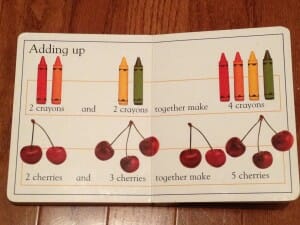 This book makes teaching these math concepts to your diaper-wearing tot easy, because it builds actual problems and comparisons into the text. After you read the question, you can help your audience solve the problem – or in the case of the addition and subtraction, count them through solving the problem themselves.
This book makes teaching these math concepts to your diaper-wearing tot easy, because it builds actual problems and comparisons into the text. After you read the question, you can help your audience solve the problem – or in the case of the addition and subtraction, count them through solving the problem themselves.
I was glad to receive this book early on, because it helped me think of ways to add similar “math problem” opportunities into other aspects of our daily lives.
Another super book about numbers is Chicka Chicka 1, 2, 3
, which gives kids an early introduction to the concept of zero as a placeholder, as well as how combining different digits (for example, tacking another zero onto the end of a 10) can make a whole new number.
4. Do math with meals
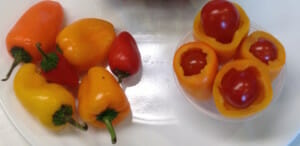 With the examples in My First Number Board Book for inspiration, I started to look for other ways to work math seamlessly into our day-to-day activities. I soon found that mealtimes were full of opportunities for this:
With the examples in My First Number Board Book for inspiration, I started to look for other ways to work math seamlessly into our day-to-day activities. I soon found that mealtimes were full of opportunities for this:
- Let’s count the cherry tomatoes and baby carrots left on your plate. Which do you have more of?
- How many green beans do you have left? If you eat one more, then how many will you have left?
- How many bites of meat do you still have? What if I give you two more pieces – then how many will you have?
- How many crackers would you like? Let’s count them.
- Which has more left in it, your milk cup or your water cup?
- Can you put your Cheerios into two equal piles? How many are in each pile?
- How many meatballs do you have? What if we cut each one in half? – then how many pieces of meatball will be on your plate?
At first, we had to do most of the counting (and pointing to each object as we said its corresponding number) out loud for each girl, of course. But by practicing this on a regular basis, they were soon able to do most of the counting (and even pointing!) by themselves. And adding or taking away one piece of food at a time was an easy way to teach them simple addition and subtraction, even if they had to count out how much food there was after each changeup we made.
5. Get your family an abacus, learn how to use it if you need to, then teach your kiddo to do math on it
If you don’t know where to start with teaching your child basic math on an abacus, there are plenty of YouTube videos to help you out. Melissa & Doug makes a nice 10×10 abacus for children, which is both sturdy and inexpensive. Although they’re recommended for kids age 3 and older, Kimmie got hers right around her first birthday; nothing about their construction makes them unsafe for younger children, and I’d argue that earlier exposure is better from a math-teaching perspective.
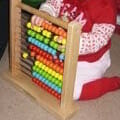
At first, your child will just have fun playing with all of the pretty colored beads on the abacus. But as soon as your child gets the hang of what teachers call “number correspondence” or “one-to-one correspondence” – the notion that each of those digits kids learn to recite when they count to 10 actually means something! – then you can teach them to count out beads on the abacus to help them add simple (one-digit plus one-digit) sums.
As your child gets older, you can teach her to do subtraction, multiplication and division, and counting by 10s on the abacus as well. By her fifth birthday, Kimmie’s idea of “fun” over lunch was bringing the abacus to the kitchen table and doing math problems with it while she ate! – and while younger sister Essie watched, and learned along with Kimmie.
6. Teach your little ones about sorting and patterns
As the girls’ preschool teachers have explained to me over the years, the ability to sort things (by size, shape, color, whatever) and the ability to recognize and form patterns are also important “pre-math skills.” There are lots of infant toys made for teaching these skills; think stacking rings and cups
, shape-sorters
, and blocks that come in different colors and sizes.
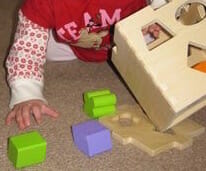 But you don’t even need toys to teach these skills to your little ones. They can play with whatever you have lying around the house that’s safe for little ones to handle – plastic cups and plates, stacking measuring cups and spoons, pots and lids, canned goods, boxes of cereal or crackers – whatever.
But you don’t even need toys to teach these skills to your little ones. They can play with whatever you have lying around the house that’s safe for little ones to handle – plastic cups and plates, stacking measuring cups and spoons, pots and lids, canned goods, boxes of cereal or crackers – whatever.
Have your child help you sort a bag of groceries into piles on the floor when you get home: cans with cans, boxes with boxes. Point out the colors, shapes, or whatever else is appropriate as you go (cans are cylinders that have circles on one ends, whereas boxes have six rectangular sides – or all the tuna fish cans are blue and white, but all the tomato cans are red and yellow).
Or have your child help you sort the kid-friendly items coming out of the dishwasher. How many plastic cups do you have of each color? Which are there more of, plastic plates or plastic bowls?
So there you have it – six simple ways, tried and proven in our household at least, to get your diaper-wearing offspring off to an early start on math literacy. I’ll cover math for preschoolers and math for school-age kids in future posts, so stay tuned!
NOTE: This site contains affiliate links. I may earn a small commission from any purchases made through affiliate links, at no additional cost to you. For more information, please read the full disclosure/privacy policy.

